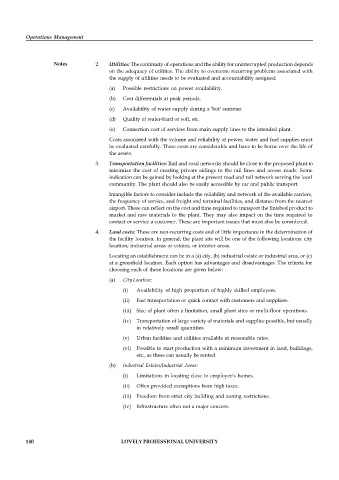Page 146 - DMGT501_OPERATIONS_MANAGEMENT
P. 146
Operations Management
Notes 2. Utilities: The continuity of operations and the ability for uninterrupted production depends
on the adequacy of utilities. The ability to overcome recurring problems associated with
the supply of utilities needs to be evaluated and accountability assigned:
(a) Possible restrictions on power availability.
(b) Cost differentials at peak periods.
(c) Availability of water supply during a 'hot' summer.
(d) Quality of water-hard or soft, etc.
(e) Connection cost of services from main supply lines to the intended plant.
Costs associated with the volume and reliability of power, water and fuel supplies must
be evaluated carefully. These costs are considerable and have to be borne over the life of
the assets.
3. Transportation facilities: Rail and road networks should be close to the proposed plant to
minimize the cost of creating private sidings to the rail lines and access roads. Some
indication can be gained by looking at the present road and rail network serving the local
community. The plant should also be easily accessible by car and public transport.
Intangible factors to consider include the reliability and network of the available carriers,
the frequency of service, and freight and terminal facilities, and distance from the nearest
airport. These can reflect on the cost and time required to transport the finished product to
market and raw materials to the plant. They may also impact on the time required to
contact or service a customer. These are important issues that must also be considered.
4. Land costs: These are non-recurring costs and of little importance in the determination of
the facility location. In general, the plant site will be one of the following locations: city
location; industrial areas or estates; or interior areas.
Locating an establishment can be in a (a) city, (b) industrial estate or industrial area, or (c)
at a greenfield location. Each option has advantages and disadvantages. The criteria for
choosing each of these locations are given below:
(a) City Location:
(i) Availability of high proportion of highly skilled employees.
(ii) Fast transportation or quick contact with customers and suppliers.
(iii) Size of plant often a limitation, small plant sites or multi-floor operations.
(iv) Transportation of large variety of materials and supplies possible, but usually
in relatively small quantities.
(v) Urban facilities and utilities available at reasonable rates.
(vi) Possible to start production with a minimum investment in land, buildings,
etc., as these can usually be rented.
(b) Industrial Estates/Industrial Areas:
(i) Limitations in locating close to employee's homes.
(ii) Often provided exemptions from high taxes.
(iii) Freedom from strict city building and zoning restrictions.
(iv) Infrastructure often not a major concern.
140 LOVELY PROFESSIONAL UNIVERSITY

